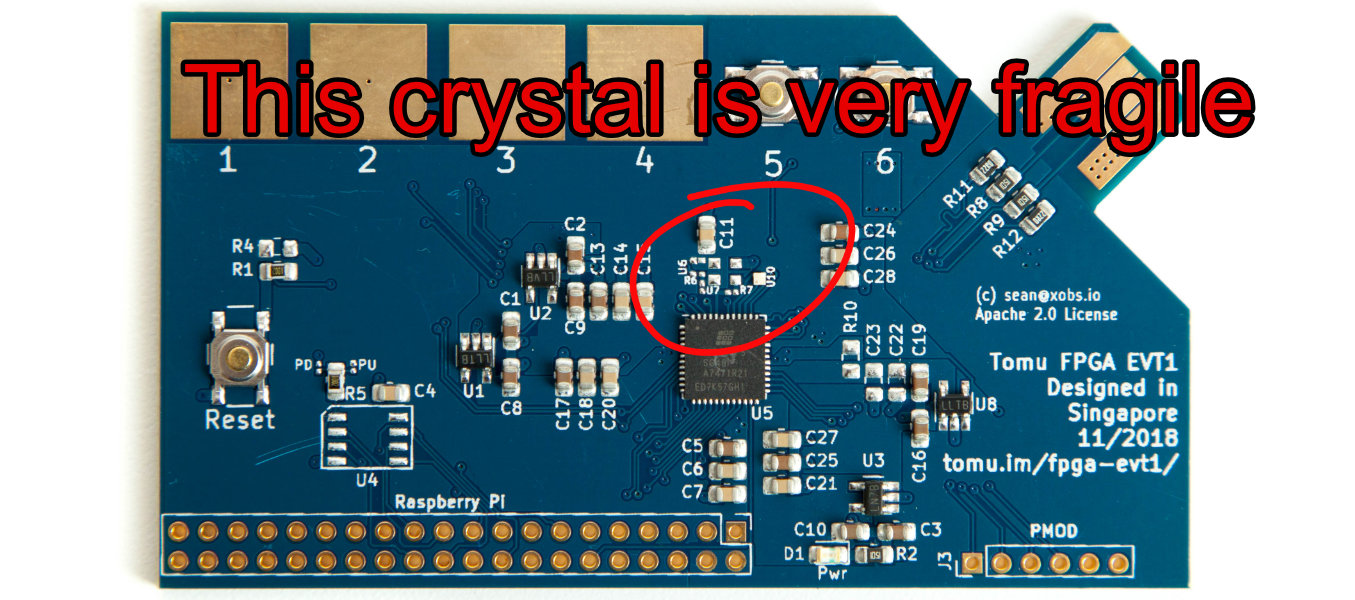
Download Software from fomu.im/td19
Fomu: An FPGA in your USB Port
A whirlwind introduction to Fomu; a workshop in three levels
Sean Cross - https://xobs.io/ - @xobs
Levels of Fomu
Fomu aims to be accessable on three levels:
- Python / Interpreter
- RISC-V / C
- FPGA / HDL
Workshop Outline
- What do I need to get started?
- What is an FPGA, and what is Fomu?
- Working with Fomu using Python, RISC-V, and HDL
What do I need to get started?
- DFU utilities
- Serial console
- RISC-V toolchain
- FPGA Toolchain
- Python 3
What is an FPGA?
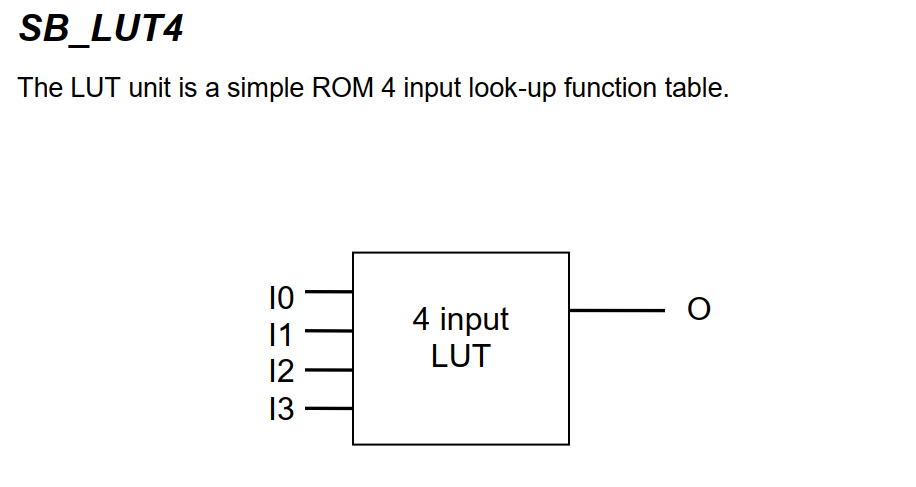
What is an FPGA?
| 0 | 1 | 2 | 3 | 4 | 5 | 6 | 7 | 8 | 9 | 10 | 11 | 12 | 13 | 14 | 15 | |
|---|---|---|---|---|---|---|---|---|---|---|---|---|---|---|---|---|
| IO0 | 0 | 0 | 0 | 0 | 0 | 0 | 0 | 0 | 1 | 1 | 1 | 1 | 1 | 1 | 1 | 1 |
| IO1 | 0 | 0 | 0 | 0 | 1 | 1 | 1 | 1 | 0 | 0 | 0 | 0 | 1 | 1 | 1 | 1 |
| IO2 | 0 | 0 | 1 | 1 | 0 | 0 | 1 | 1 | 0 | 0 | 1 | 1 | 0 | 0 | 1 | 1 |
| IO3 | 0 | 1 | 0 | 1 | 0 | 1 | 0 | 1 | 0 | 1 | 0 | 1 | 0 | 1 | 0 | 1 |
| O | ? | ? | ? | ? | ? | ? | ? | ? | ? | ? | ? | ? | ? | ? | ? | ? |
What is an FPGA?
module example (output reg [0:5] Q, input C);
reg [0:8] counter;
always @(posedge C)
begin
counter <= counter + 1'b1;
Q = counter[7] ^ counter[5] | counter<<2;
end
endmodule

About the ICE40UP5K
- 5280 4-input LUTs (LC)
- 16 kilobytes BRAM
- 128 kilobytes "SPRAM"
- Current-limited 3-channel LED driver
- 2x I2C and 2x SPI
- 8 16-bit DSP units
- Warmboot capability
- Open toolchain
What is Fomu?
- ICE40UP5K
- 2MB QSPI flash memory
- Four edge-plated pads
- ESD protection
- USB implemented in HDL
- Fits in your USB port
Fomu Block Design Diagram
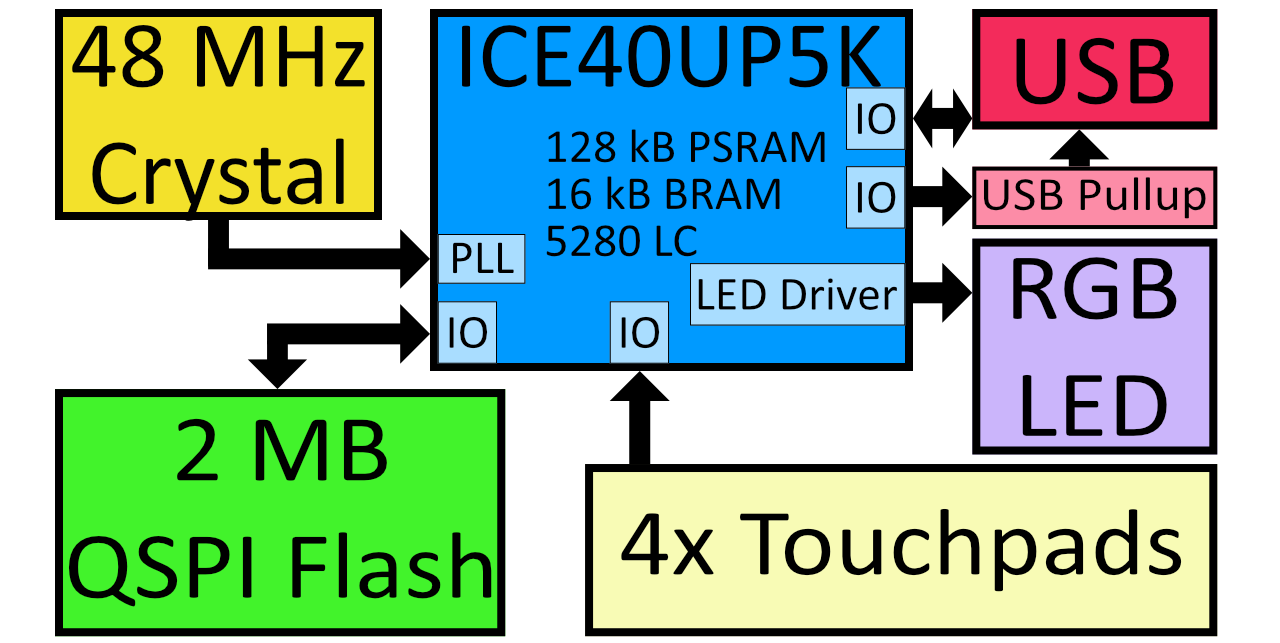
What is this PCB?
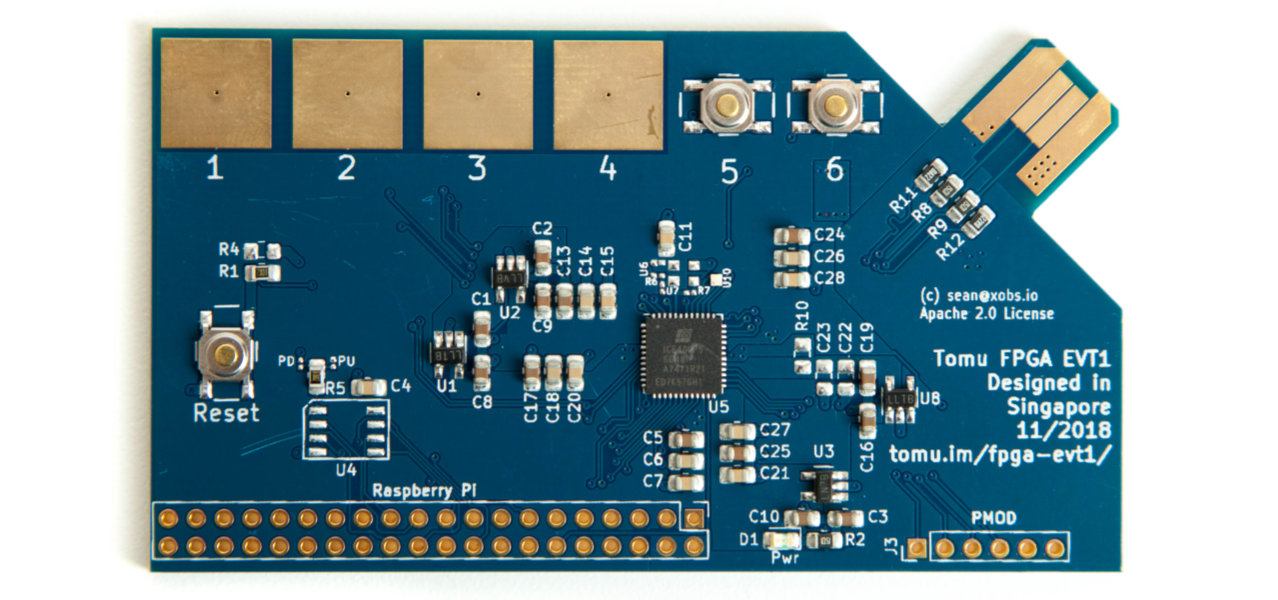
Fomu EVT1
Misleading Datasheets
What modifications does it have?
- Shorting out two zero-ohm resistors (R7, PU)
- Programming SPI flash
- Bending SPI flash pins inward (U4)
- Mounting crystal on its side (U7)
- Attaching power to crystal
Fomu SPI Flash Layout
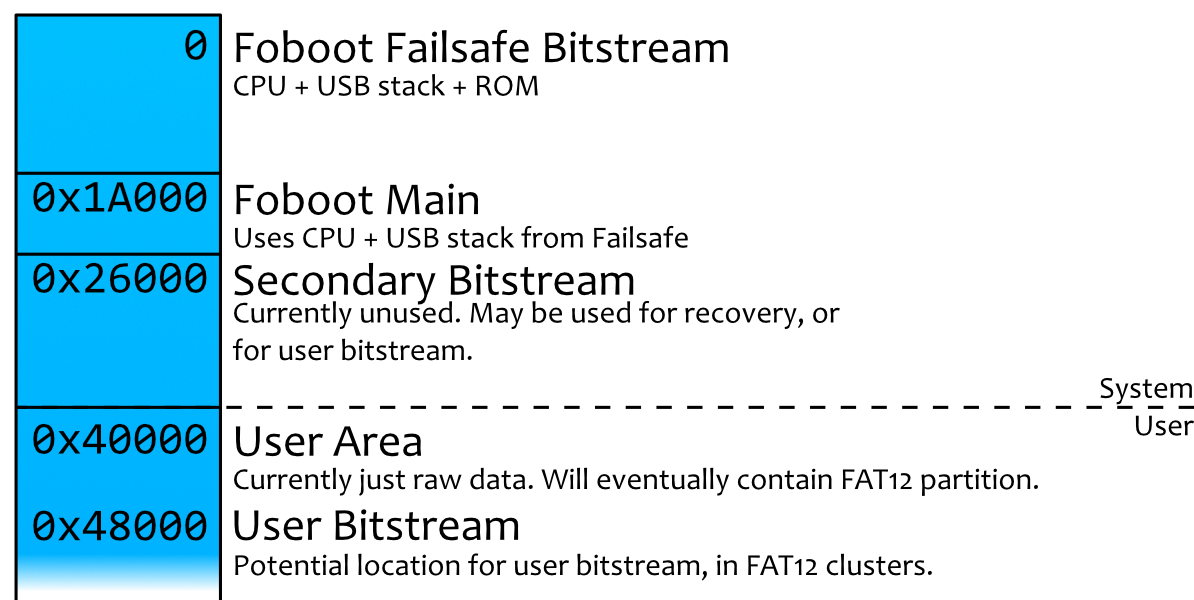
Working with Fomu
FAT Bootloader
- Presents itself as a USB disk
- Drag and drop files to program
- Multiple interpreter support

"fail safe" bootloader
Device Firmware Update - DFUUpdating Fomu
$ dfu-util -l
Found DFU: [1209:5bf0] name="Fomu DFU Bootloader v1.7.2"
$ dfu-util -D evt-installable.dfu
Download [========= ] 36% 38912 bytes
Download done.
$ dfu-util -l
Found DFU: [1209:5bf0] name="Fomu DFU Bootloader v1.8.1"
$Python / Interpreted
- Goal: Multiple interpreters, auto-reload, USB disk interface
- Now: MicroPython binary
Loading Programs onto Fomu
$ dfu-util -l
Found DFU: [1209:5bf0] name="Fomu DFU Bootloader v1.8.1"
$ dfu-util -e # Boot current program
$ dfu-util -D new-image.dfu # Load new programu5b f0mu
Loading MicroPython
$ dfu-util -D micropython-fomu.dfuConnecting via serial
screen /dev/cu.usbserial*screen /dev/ttyACM*Tera TermMicroPython v1.10-296-g0a5a77a on 2019-06-18; fomu with vexriscv
>>>Interacting with Fomu
>>> import fomu
>>> rgb = fomu.rgb()
>>> rgb.mode("error")
>>>
Read SPI ID
>>> spi = fomu.spi()
>>> hex(spi.id())
'0xc2152815'
>>>
Memory-Mapped Registers
#define CSR_VERSION_MAJOR_ADDR 0xe0007000
#define CSR_VERSION_MINOR_ADDR 0xe0007004
#define CSR_VERSION_REVISION_ADDR 0xe0007008>>> import machine
>>> machine.mem32[0xe0007000]
1
>>>RGB LED Driver reference

>>> rgb.write_raw(0b0001, 255)
>>> rgb.write_raw(0b1010, 14)
>>> rgb.write_raw(0b1011, 1)
>>> Future Work
- CircuitPython
- eLua
- Espurino?
RISC-V
LiteX Model
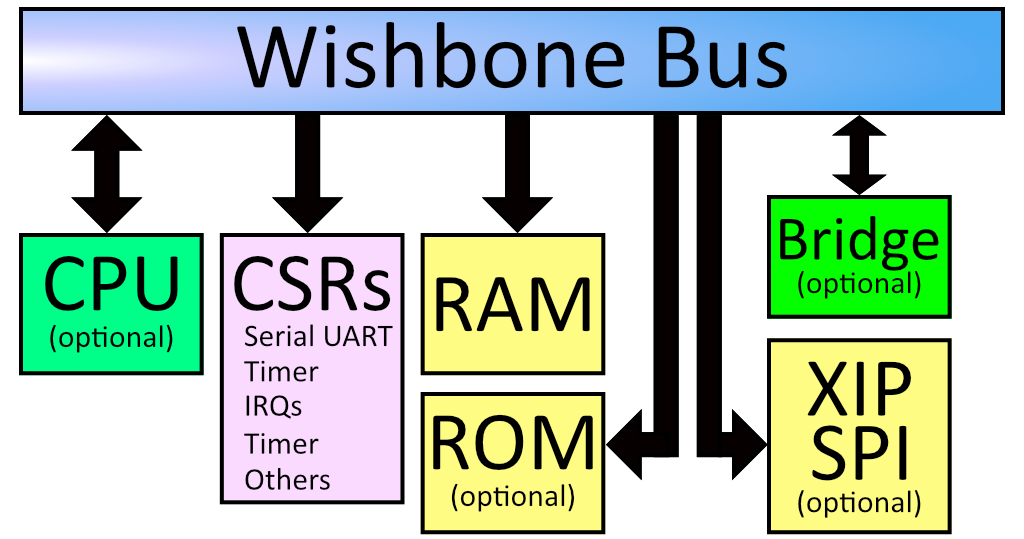
Wishbone Bridge
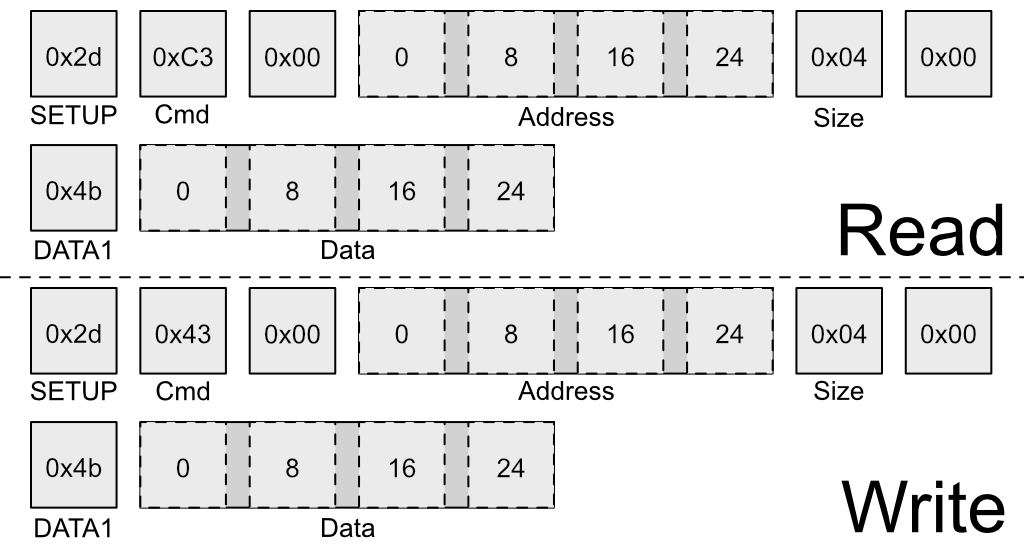
CPU is Optional
- Multiple CPUs available
-
- VexRiscv
- picorv32
- lm32
- ...
- Also works just fine with no CPU
CSR Access
#define CSR_VERSION_MAJOR_ADDR 0xe0007000
#define CSR_VERSION_MAJOR_SIZE 1
#define CSR_VERSION_MINOR_ADDR 0xe0007004
#define CSR_VERSION_MINOR_SIZE 1
#define CSR_VERSION_REVISION_ADDR 0xe0007008
#define CSR_VERSION_REVISION_SIZE 1
#define CSR_VERSION_GITREV_ADDR 0xe000700c
#define CSR_VERSION_GITREV_SIZE 4
#define CSR_VERSION_GITEXTRA_ADDR 0xe000701c
#define CSR_VERSION_GITEXTRA_SIZE 2
csr.h
Reading CPU Version
$ wishbone-tool --pid 0x5bf0 0xe0007000
Value at e0007000: 00000001
$ wishbone-tool --pid 0x5bf0 0xe0007004
Value at e0007004: 00000008
$ wishbone-tool --pid 0x5bf0 0xe0007008
Value at e0007008: 00000001Interacting with LEDD directly

#define CSR_RGB_DAT_ADDR 0xe0006800L
#define CSR_RGB_ADDR_ADDR 0xe0006804L$ wishbone-tool --pid 0x5bf0 0xe0006804 1
$ wishbone-tool --pid 0x5bf0 0xe0006800 0xffWriting RISC-V Code
$ make
CC ./src/main.c main.o
CC ./src/rgb.c rgb.o
CC ./src/time.c time.o
AS ./src/crt0-vexriscv.S crt0-vexriscv.o
LD riscv-blink.elf
OBJCOPY riscv-blink.bin
IHEX riscv-blink.ihex
$
From riscv-blink directory in teardown2019-workshop
Modifying RISC-V Code
--- a/riscv-blink/src/main.c
+++ b/riscv-blink/src/main.c
@@ -38,6 +38,7 @@ void isr(void) {
void main(void) {
rgb_init();
irq_setie(0);
+ rgb_write((100000/64000)-1, LEDDBR);
int i = 0;
while (1) {
i++;Other RISC-V Programs
riscv-usb-cdcacm: echo characters back after adding 1Hardware Description Language
Yosys and NextPNR
- Timing Driven!
Max frequency for clock 'clk12': 24.63 MHz (PASS at 12.00 MHz)
Max frequency for clock 'clk48_1': 60.66 MHz (PASS at 48.00 MHz)
Max frequency for clock 'clkraw': 228.05 MHz (PASS at 48.00 MHz)Blinking an LED
$ make FOMU_REV=evt
...
20 warnings, 0 errors
PACK blink.bin
Built 'blink' for Fomu evt1
$ dfu-util -D blink.binLiteX and MiGen
- Define hardware in Python
- Evaluate Python to produce netlist
- Synthesize netlist to FPGA
lxbuildenv.py
- Python environment using native interpreter
- Very stable, good for hardware projects
- Should work with system Python
- Runs on Linux, Windows, Raspberry Pi
Why do we need a CPU?

What if we remove the CPU?
- Workshop project has no CPU
- DummyUsb module automatically enumerates
- Wishbone Debug Bridge still accessible
Build Workshop Module
$ python3 workshop.py --placer heap
...
5 warnings, 0 errors
$ Load onto Fomu
$ dfu-util -D build/gateware/top.bin
Download [=========================] 100% 104090 bytes
Download done.
$ Write a value to RAM
$ wishbone-tool --pid 0x5bf0 0x10000000
Value at 10000000: 0baf801e
$ wishbone-tool --pid 0x5bf0 0x10000000 0x12345678
$ wishbone-tool --pid 0x5bf0 0x10000000
Value at 10000000: 12345678
$ Adding Hardware
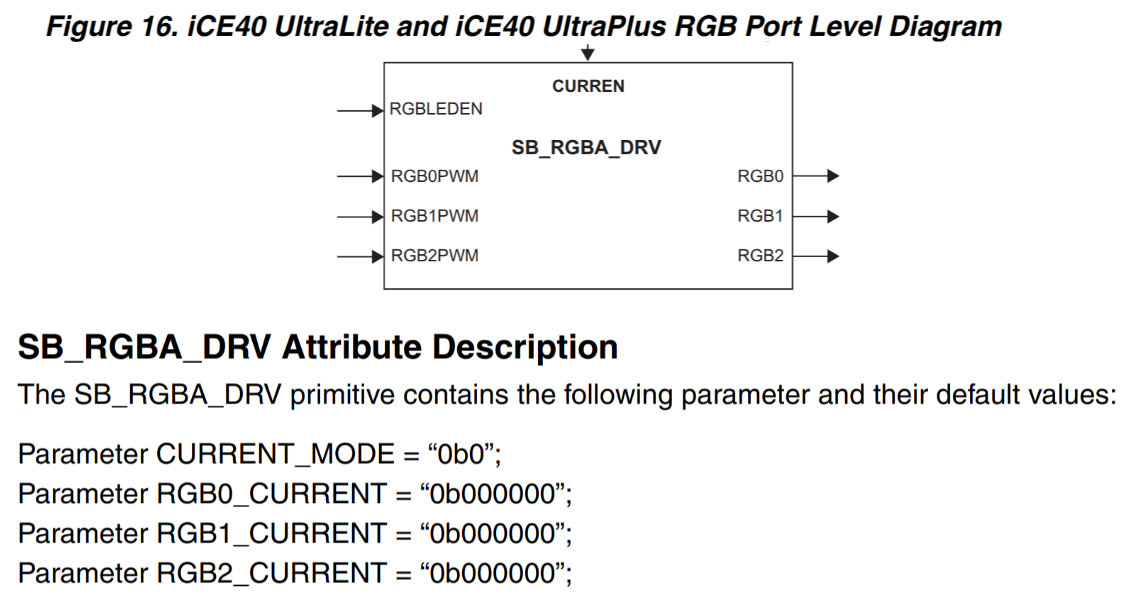
Technology Library Reference
// Verilog Instantiation
SB_RGBA_DRV RGBA_DRIVER (
.CURREN(ENABLE_CURR),
.RGBLEDEN(ENABLE_RGBDRV),
.RGB0PWM(RGB0),
.RGB1PWM(RGB1),
.RGB2PWM(RGB2),
.RGB0(LED0),
.RGB1(LED1),
.RGB2(LED2)
);
defparam RGBA_DRIVER.CURRENT_MODE = "0b0";
defparam RGBA_DRIVER.RGB0_CURRENT = "0b111111";
defparam RGBA_DRIVER.RGB1_CURRENT = "0b111111" ;
defparam RGBA_DRIVER.RGB2_CURRENT = "0b111111";SBTICETechnologyLibrary201504.pdf page 147
RGB Block
class FomuRGB(Module, AutoCSR):
def __init__(self, pads):
self.output = CSRStorage(3)
self.specials += Instance("SB_RGBA_DRV",
i_CURREN = 0b1,
i_RGBLEDEN = 0b1,
i_RGB0PWM = self.output.storage[0],
i_RGB1PWM = self.output.storage[1],
i_RGB2PWM = self.output.storage[2],
o_RGB0 = pads.r,
o_RGB1 = pads.g,
o_RGB2 = pads.b,
p_CURRENT_MODE = "0b1",
p_RGB0_CURRENT = "0b000011",
p_RGB1_CURRENT = "0b000011",
p_RGB2_CURRENT = "0b000011",
)Instantiating FomuRGB
@@ -55,6 +75,10 @@ class BaseSoC(SoCCore):
with_ctrl=False,
**kwargs)
+ # Add the LED driver block
+ led_pads = platform.request("rgb_led")
+ self.submodules.rgb = FomuRGB(led_pads)
+
# UP5K has single port RAM....
# Use this as CPU RAM.
spram_size = 128*1024Interacting with the CSR
csr_register,rgb_output,0xe0006800,1,rwFrom test/csr.csv